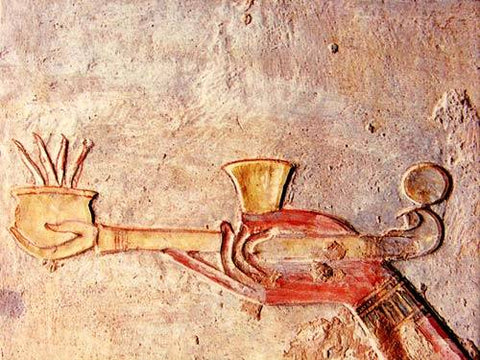
Sacred Smoke: The Ancient History and Timeless Art of Burning Resins
Awaken To The OneShare
The Ancient Art of Burning Resins: A Journey Through Time
Burning aromatic resins is one of the oldest and most universal practices in human history. From ancient rituals to modern wellness trends, the act of burning resins such as frankincense, myrrh, copal, and benzoin transcends cultures and centuries. This practice connects humanity to the sacred, to nature, and to each other, and its history is as rich and layered as the fragrances it produces. Whether used for religious purposes, healing, or personal enjoyment, the story of burning resins is one of timeless beauty and enduring significance.
What Are Resins?
Resins are natural substances secreted by certain trees, particularly conifers and species in the Burseraceae family (such as Boswellia and Commiphora). When the bark of these trees is injured, they exude a sticky, fragrant sap to protect themselves, sealing wounds and preventing infection. Over time, this sap hardens into resin, a prized natural material with incredible aromatic and medicinal properties. When burned, resins release aromatic smoke filled with volatile compounds, which are often considered cleansing, calming, and spiritually uplifting. These qualities made resins integral to rituals, trade, and medicine across civilizations.
The Origins of Burning Resins
The use of resins dates back thousands of years, predating written records. Archaeological evidence reveals that early humans burned aromatic substances as part of spiritual and practical activities, creating fragrant smoke to purify spaces, ward off pests, and honor deities. Some of the oldest known examples include:
1. Prehistoric Use
The origins of resin burning may stretch as far back as the Paleolithic period. Early humans likely stumbled upon the fragrant properties of certain woods and resins while using fire for warmth and cooking. As resins released their captivating aromas when exposed to flames, humans may have recognized their calming effects and symbolic power, inspiring the first intentional burning of resins during rituals or gatherings. Charred remains of resinous materials found in prehistoric caves suggest that aromatic substances were already deeply intertwined with spiritual and ceremonial practices.
2. Ancient Egypt
In ancient Egypt, resin burning reached new levels of cultural and spiritual significance. Frankincense and myrrh were central to religious ceremonies and embalming rituals. These resins were considered gifts of the gods, and their smoke was believed to carry prayers and offerings to the divine realm. Temples were perfumed with the scent of burning incense, creating sacred atmospheres for worship. Frankincense and myrrh also played a key role in mummification, as their antimicrobial properties helped preserve bodies while their aroma sanctified the dead. The resins were so highly valued that they became luxury items reserved for royalty and the priesthood.
3. Mesopotamia and the Fertile Crescent
In Mesopotamian civilizations, such as the Sumerians, Akkadians, Babylonians, and Assyrians, resin burning was an integral part of temple rituals and religious ceremonies. Temples dedicated to gods like Ishtar, Marduk, and Enlil were filled with the fragrant smoke of burning resins, which were believed to attract divine favor and create a connection between mortals and deities. Tablets from this region contain some of the earliest known recipes for incense, showcasing a sophisticated understanding of blending aromatic substances to create desired effects. The Mesopotamians also used resins for medicinal purposes and to ward off malevolent spirits.
Resins on the Silk Road and Spice Routes
As trade networks expanded, resins became some of the most valuable commodities in the ancient world, driving the development of the incense trade routes. These routes stretched from the Arabian Peninsula to the Mediterranean, India, and beyond, connecting civilizations and spreading the use of resins.
1. Arabia: The Land of Frankincense
Southern Arabia, particularly the regions of modern-day Oman and Yemen, became known as the "Land of Frankincense." Boswellia trees, which produce frankincense resin, thrived in this arid region, and their resin was one of the most sought-after products of the ancient world. Arabian merchants transported frankincense via camel caravans across vast deserts to markets in Egypt, Mesopotamia, Greece, and Rome. The wealth generated by the frankincense trade helped shape the history and culture of the Arabian Peninsula.
2. India and the Sacred Smoke
In India, resins such as guggul (a resin from the Commiphora mukul tree) and benzoin were integral to spiritual practices and healing traditions. Burning resins was, and still is, an essential part of Hindu rituals, where the aromatic smoke is thought to purify the space, create a sacred atmosphere, and invite the presence of the divine. The fragrant clouds of smoke produced by dhoop (resin incense) enhance meditation, prayer, and ceremonies such as weddings and temple offerings. Ayurveda, India’s ancient system of medicine, also recognizes the therapeutic properties of resins, using them to treat respiratory issues, skin conditions, and emotional imbalances.
3. East Asia and the Rise of Incense Culture
In East Asia, resin burning evolved into a refined art form that blended spiritual and aesthetic elements. During the Tang Dynasty in China, incense burning became central to Buddhist rituals and Taoist practices, as the rising smoke symbolized the ascent of prayers and intentions. Similarly, in Japan, the art of incense burning—known as Kōdō, or the "Way of Incense"—flourished during the Heian period. Kōdō elevated resin burning to a ceremonial practice, emphasizing mindfulness and sensory appreciation. Resins like aloeswood (agarwood) and sandalwood, often blended with other aromatic materials, became the foundation of East Asian incense traditions.
Resins in the Mediterranean and Classical Antiquity
The Greeks and Romans embraced resins for their religious, therapeutic, and decorative uses. In Greek temples, frankincense and myrrh were burned as offerings to the gods, while oracles used the smoke to enhance states of trance and divination. The Romans, on the other hand, integrated resin burning into nearly every aspect of daily life. Temples, homes, and public baths were perfumed with aromatic smoke. Myrrh and frankincense were also prized ingredients in perfumed balms, medicines, and cosmetics. Roman elites valued resins so highly that they were often used as a form of currency or tribute, and their trade routes spanned the known world.
Resins in Sacred Texts and Religious Traditions
Resins hold a central place in the religious texts and traditions of many cultures. In Judaism, frankincense and other resins were burned as offerings in the Tabernacle, with specific recipes for incense outlined in the Torah. In Christianity, the gifts of the Magi—gold, frankincense, and myrrh—highlight the sacred and symbolic importance of these resins. In Islam, burning frankincense is a common practice to create a holy atmosphere and ward off negative influences. Similarly, Indigenous cultures worldwide, such as the Mayans and Aztecs, burned resins like copal during sacred ceremonies to honor their gods and ancestors.
The Decline and Resurgence of Resin Burning
While the industrial age saw a decline in traditional resin burning, the practice has seen a resurgence in modern times. The growing interest in natural wellness, aromatherapy, and spirituality has revived the ancient art of burning resins. Today, resins are used for meditation, energy cleansing, and personal rituals, often paired with mindfulness practices or holistic healing. Artisanal incense makers are also rekindling the tradition of crafting high-quality resin blends, honoring ancient techniques while adapting them to contemporary lifestyles.
The Timeless Appeal of Resins
Burning resins is more than just a sensory experience—it’s a connection to the sacred, to nature, and to the collective history of humanity. Each whiff of aromatic smoke carries with it the wisdom of generations, the beauty of ancient rituals, and the universal human longing for the divine. To burn resins today is to step into a tradition as old as civilization itself, preserving an art that continues to inspire, heal, and transform.
Conclusion: The Timeless Legacy of Sacred Smoke
The history of burning resins is a testament to humanity’s enduring connection to the natural world and the sacred. Across continents and cultures, resins like frankincense, myrrh, copal, and benzoin have played a profound role in spiritual, medicinal, and ceremonial practices. Whether used to honor gods, cleanse spaces, or simply enjoy their calming fragrance, these aromatic gifts of nature have transcended time, enriching human lives for millennia.
In today’s world, as we seek to reconnect with ancient traditions and embrace holistic wellness, burning resins offers a simple yet powerful way to ground ourselves, find inner peace, and celebrate the timeless beauty of nature. Each plume of fragrant smoke links us to the wisdom of the past, reminding us of the shared human desire to create moments of reverence, reflection, and connection.
Whether you’re lighting frankincense to meditate, using copal to cleanse your home, or exploring the artistry of blending resins, you are participating in a ritual that unites generations. The art of burning resins is more than a practice—it’s a journey through history, a celebration of the sacred, and an invitation to bring a sense of wonder and tranquility into your daily life.
So the next time you burn a piece of resin, take a moment to honor its ancient legacy, appreciate its natural origins, and immerse yourself in the timeless aroma that has shaped human culture for centuries. The sacred smoke of resins continues to rise, just as it has for thousands of years, carrying with it the echoes of humanity’s shared story.
